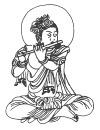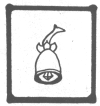The Power of Recitation
An Unstudied Aspect of Chinese Buddhism
-By
Professor Yun-hua Jan
McMaster
University
Ontario,
Canada.
1
Although recitation of scriptures is a common phenomenon in various religious traditions, when one looks for information on the subject, one finds that this practice is not mentioned in almost any standard reference book. If the non-discussion of recitation seems strange to the student of history of religions, the account of Chinese religious phenomena is even more curious. Based on a passage from the Analects, E. O. James concludes that "prayer had no place" in Confucian ethics1. Although he conceded the existence of prayer in later Confucian tradition, he played down the item merely as a passing reference. When one turns to the Buddhist practices, T. W. Rhys Davids, has limited the discussion of hymns to India and Ceylon, but completely omitted China2. Other writers who have written on relevant terms, have discussed Japanese Buddhist prayers, or Tibetan Buddhist charms, but again nothing on Chinese Buddhism. The absence of Chinese subjects on this matter leads us to these questions: Are Chinese people absolutely rational and ethical? Are they not interested or is there no need for other vehicles in their religious striving? When one looks into Chinese Buddhist histories, the answers to these questions are all negative. The Chinese, just like most other traditions, were interested and had applied other means in their religious effort.
A study of Chinese Buddhist literature will confirm that the Chinese Buddhists, long before their Japanese and Tibetan brethren, had fully recognized the power of recitation. They regarded recitation as one of the powerful means to achieve a religious goal. In the Kao-Seng chuan or "Biography of Eminent Monks", Hui-chio, (496-554), the well-known Buddhist historian, has included 11 eminent monks under the section of Ching-shih or "Scriptural Teachers", and appended another eight under the same category though he did not write a biography for them3. This respect for those who have expertise in recitation has been followed up by another eminent historian, Tao-Hsuan (595-667), the author of Hsu Kao-seng chuan ("Further Biography of Eminent Monks"). Tao-Hsuan included the fourteen monks as the eminent ones on the subject, and appended another eight names to it. He has also changed the title of the category from "Scriptural Teachers" to "Reciters". (tu-sung)4. The third historian of this biographical series was Tsan-ning (919-1001)5, who has followed the steps of Tao-Hsuan by calling the section "Reciters", and has listed fifty monks under the title with forty-two of then as biographies. These figures are significantly high in number, which indicates how popular recitation was among Chinese Buddhist monks during the period between the IVth and Xth centuries A.D. It is true that from the scholarly viewpoint, without a clear understanding of the recited text, recitation itself alone does not lead one to deliverance. Nevertheless, if a reciter understands what he recites, his religious experience would be more personal and powerful than discursive knowledge. Even the most learned scholar like Tsan-ning himself, although he considers that the wisdoms produced from the three practices (san-hui) of hearing, contemplation and meditation are the essential entrances into the Tao, did concede that "if one prefers the hearing and memorization, there is no other practice that surpasses recitation".6 This view of course, comes from a scholar. A reciter's experience and his ranking of religious paths would be quite different. He would, as we shall see, give more preference to recitation rather than bookish knowledge. In the following pages, this paper will take a few examples from the three collections of biographies on the eminent monks and explain how powerful recitation is in Chinese Buddhism. It has to be noted that all the examples are from biographies of eminent monks, and that they are claimed to be neither theory nor hypothesis, but real experiences.
11
a
The early monks who were eminent in recitation, as recorded in the collection of biographies, gave readers three distinctive impressions. First, most of them had recited verses or sung songs. The musical talent of these monks was highly admired by the public, hence helpful to the spread of the religion. This flourishing of religious songs was a result of confrontation between syllabic Sanskrit and monosyllabic Chinese. The Chinese Buddhist songs in the period were not an imitation but a creative adaptation of Indian religious chanting. Hui-chiao writes very clearly on this point, "Since the great religion (i.e. Buddhism) spread to the East, there were many translations of literature, but fewer in vocal transmission"7 The historian has given the reason as follows: "This was so because Sanskrit is polysyllabic where the Chinese language is monosyllabic. To sing a Sanskrit song in a Chinese tune is like accommodating many syllables in a short tune. To sing Chinese words in a Sanskritic tune would make both the words and the tunes hurried.8 Another point worth noting is the emphasis on the balance between the tone and the text in the recitation. The biographer considered that the standard recitation, "estimates the achievement both in tones and in words. If one only has tones but not the words, the Mind of Tao has no way to be produced. If one has the words but not the tones, one would fail to enter into worldly sentiment.9 It was with this balance between the meaning and the tones that the Buddhist reciters attained eminence in their religious lives.
The second characteristic of the early Chinese Buddhist recitations is vocal. The biographer recorded that a certain monk, Fa-ch'iao, was interested in recitation since his youth but was without talent. He was often depressed by it, hence decided to fast for seven days and nights. During that period, he made confession and worshiped Bodhisattva Kuan Yin, and prayed for a response in his life. When he reached the seventh day of the fast, he felt that his throat had cleared up. He washed his mouth and began to sing. His clear voice was audible within a distance more than a Li, which attracted a large crowd to his recitation.10
There was another monk named Chih T'an-yo, who claimed that he learned the technique of recitation from a heavenly god (deva) in a dream. Thereafter, he composed a number of songs and sang them with a marvelous voice.11

The third characteristic of early recitation has a supernatural color. Here the historian informed us that there was a monk called Seng-pien (d. 493) who was interested in recitation since his childhood, and was well trained by two teachers. Toward the later part of his life, he composed and sang his songs with such talent that he became the foremost in recitation in the Ch'i Kingdom. Once while he was singing in a lay devotee's house, there suddenly came a flock of cranes. They dropped in at the yard and flew away after the monk completed a chapter of the scripture.12
